 Porto is an ancient city of artists, artisans and winemakers where the coffee is strong, locals drag on cigarettes while talking urgently into mobile phones, and camera-clad tourists argue over their street maps. Last week I did what I always do in a new urban location: walked the streets. Graffiti is everywhere but in some of the back streets it is of a superior quality. These even appear to be signed – ‘Hazul’.
Porto is an ancient city of artists, artisans and winemakers where the coffee is strong, locals drag on cigarettes while talking urgently into mobile phones, and camera-clad tourists argue over their street maps. Last week I did what I always do in a new urban location: walked the streets. Graffiti is everywhere but in some of the back streets it is of a superior quality. These even appear to be signed – ‘Hazul’. 
 But the decoration of outer walls is not a new art in Porto. Azulejo – hand painted ceramic tiling – has been used in Portugal for at least 500 years, seen here on Igreja dos Carmelitas near the Praça de Gomes Teixeira.
But the decoration of outer walls is not a new art in Porto. Azulejo – hand painted ceramic tiling – has been used in Portugal for at least 500 years, seen here on Igreja dos Carmelitas near the Praça de Gomes Teixeira. 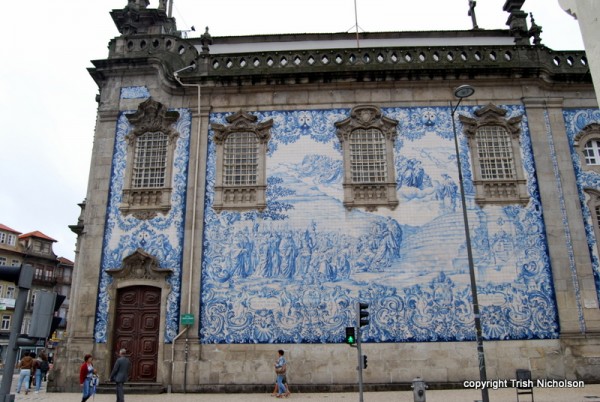

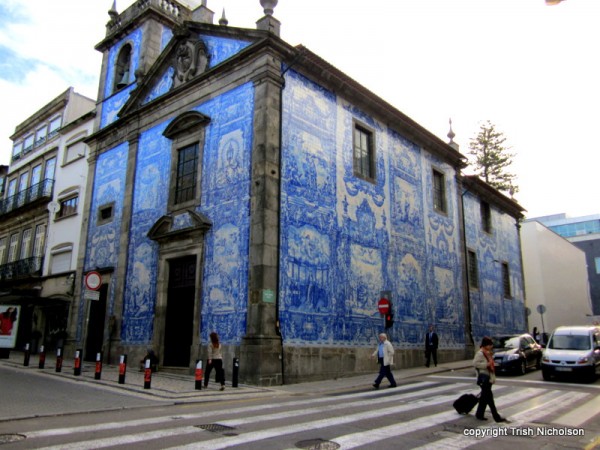 And on the other side of the city, around the main shopping street of Rua Santa Catarina, even the pavements feature mosaics.
And on the other side of the city, around the main shopping street of Rua Santa Catarina, even the pavements feature mosaics.  And in the foyer of the main railway station – Sao Bento, built in 1916 – you could miss your train wall-gazing the history of Porto.
And in the foyer of the main railway station – Sao Bento, built in 1916 – you could miss your train wall-gazing the history of Porto. 
 My previous visit to Porto was in the early 1980s on a mission from the European Union (then the EEC) and once the traditional hospitality began, especially the port, my memories became hazy. I remembered only its antiquity: Celtic ruins date from around 300 BC; the Roman Empire absorbed it in the 4th century, and the Moors invaded in AD 711, influencing art and architecture (including azulejo) until the region’s liberation in AD 868 by Count Vimara Perés, who established the first county of Portugal.
My previous visit to Porto was in the early 1980s on a mission from the European Union (then the EEC) and once the traditional hospitality began, especially the port, my memories became hazy. I remembered only its antiquity: Celtic ruins date from around 300 BC; the Roman Empire absorbed it in the 4th century, and the Moors invaded in AD 711, influencing art and architecture (including azulejo) until the region’s liberation in AD 868 by Count Vimara Perés, who established the first county of Portugal.  The wider metropolitan area of Porto houses nearly two million inhabitants in modern, sometimes prestigiously avant-garde structures (the Porto School of Architecture is renowned worldwide), but the old city centre has been a UNESCO World Heritage Site since 1996. Scaffolding and road works are everywhere, evidence of the long, slow process of rehabilitation. Renovation and dereliction live side by side. History and modernity coexist in other interesting ways, too. I had a coffee in the famous Majestic Cafe in the Rua Santa Catarina, of course. Designed in 1921 by the architect Joao Queirós, these lavish surroundings became an elite venue for the political and artistic intrigues of the intelligentsia at a period when the new Portuguese Republic, born of rebellion, siege and civil war, was a mere 10 years old.
The wider metropolitan area of Porto houses nearly two million inhabitants in modern, sometimes prestigiously avant-garde structures (the Porto School of Architecture is renowned worldwide), but the old city centre has been a UNESCO World Heritage Site since 1996. Scaffolding and road works are everywhere, evidence of the long, slow process of rehabilitation. Renovation and dereliction live side by side. History and modernity coexist in other interesting ways, too. I had a coffee in the famous Majestic Cafe in the Rua Santa Catarina, of course. Designed in 1921 by the architect Joao Queirós, these lavish surroundings became an elite venue for the political and artistic intrigues of the intelligentsia at a period when the new Portuguese Republic, born of rebellion, siege and civil war, was a mere 10 years old. 
 While alongside the impressive 18th and 19th century landmarks of the Avenida dos Aliados, MacDonald’s tries to capture something of its grandeur for a rather different clientele.
While alongside the impressive 18th and 19th century landmarks of the Avenida dos Aliados, MacDonald’s tries to capture something of its grandeur for a rather different clientele. 
 The broad, paved Avenida dos Aliados now forms the core of Porto with the city hall at the top, a statue of Henry the Navigator at the bottom, and magnificent historic buildings on either side.
The broad, paved Avenida dos Aliados now forms the core of Porto with the city hall at the top, a statue of Henry the Navigator at the bottom, and magnificent historic buildings on either side. 
 But one also needs to concentrate on the moment and the ever present danger of being run over by a sudden surge of Segways.
But one also needs to concentrate on the moment and the ever present danger of being run over by a sudden surge of Segways.  Hiring these to get about the lazy way is a bit of a ‘have’, because apart from this central avenue, the pavements are too constricted and roads too full of traffic to use them anywhere else. During rush hours narrow lanes are choked with wildly honking cars and even buses have to bend in the middle.
Hiring these to get about the lazy way is a bit of a ‘have’, because apart from this central avenue, the pavements are too constricted and roads too full of traffic to use them anywhere else. During rush hours narrow lanes are choked with wildly honking cars and even buses have to bend in the middle. 
 The mind boggles to imagine the scene in 1960 when, for the second time, the cobbled streets of Porto hosted the Formula One Portuguese Grand Prix (around the Circuito da Boavista). Only four cars finished within five laps of the winner, Jack Brabham. Escaping traffic fumes for an overview of the city, I climbed up Igreja e Torre dos Clérigos, the 200+ narrow, spiralling stone steps of the bell tower of the Cleric’s Church, a Baroque place of worship appropriately shimmering from floor to ceiling with gold ornamentation.
The mind boggles to imagine the scene in 1960 when, for the second time, the cobbled streets of Porto hosted the Formula One Portuguese Grand Prix (around the Circuito da Boavista). Only four cars finished within five laps of the winner, Jack Brabham. Escaping traffic fumes for an overview of the city, I climbed up Igreja e Torre dos Clérigos, the 200+ narrow, spiralling stone steps of the bell tower of the Cleric’s Church, a Baroque place of worship appropriately shimmering from floor to ceiling with gold ornamentation. 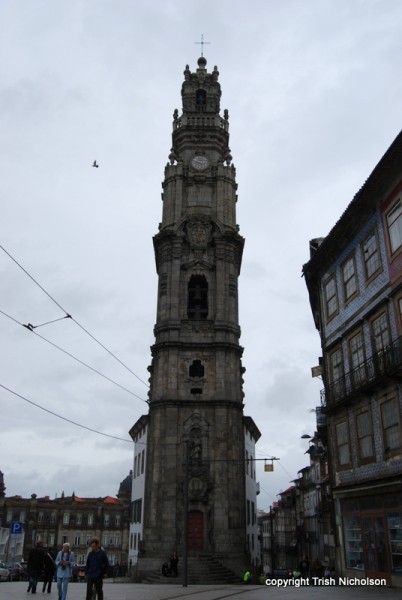 From the top of the tower is a good view of Cais de Ribeira, the old quay district along the Douro River. Here, extensive port cellars store the areas ‘liquid gold’ which used to flow by boat from the terraced vineyards of the Douro Valley but is now transported by road and rail.
From the top of the tower is a good view of Cais de Ribeira, the old quay district along the Douro River. Here, extensive port cellars store the areas ‘liquid gold’ which used to flow by boat from the terraced vineyards of the Douro Valley but is now transported by road and rail.  Below, the grey twin towers in the distance mark Porto Cathedral, austere bastion of the Catholic faith. Begun in 1110 and completed in the 13th century, it is the oldest surviving building in the city.
Below, the grey twin towers in the distance mark Porto Cathedral, austere bastion of the Catholic faith. Begun in 1110 and completed in the 13th century, it is the oldest surviving building in the city. 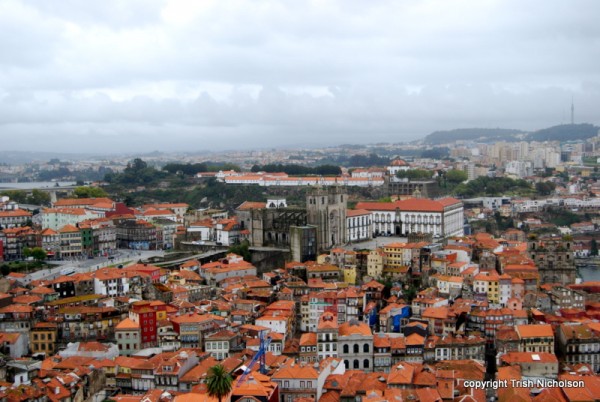
 And yes, those are olive trees on that new roof garden. Porto offers hundreds of restaurants and cafes; regular readers know better than to expect much of a gastronomic gazette from me, but I will make two recommendations. Those craving Earl Grey tea and amazing cakes can try Café Aliança, halfway down Avenida dos Aliados (on the right if facing City Hall); the health conscious can order Beba Fruta made from 100% fruit pulp with a choice, among others, of mango, papaya, Barbados cherry or cashew.
And yes, those are olive trees on that new roof garden. Porto offers hundreds of restaurants and cafes; regular readers know better than to expect much of a gastronomic gazette from me, but I will make two recommendations. Those craving Earl Grey tea and amazing cakes can try Café Aliança, halfway down Avenida dos Aliados (on the right if facing City Hall); the health conscious can order Beba Fruta made from 100% fruit pulp with a choice, among others, of mango, papaya, Barbados cherry or cashew. 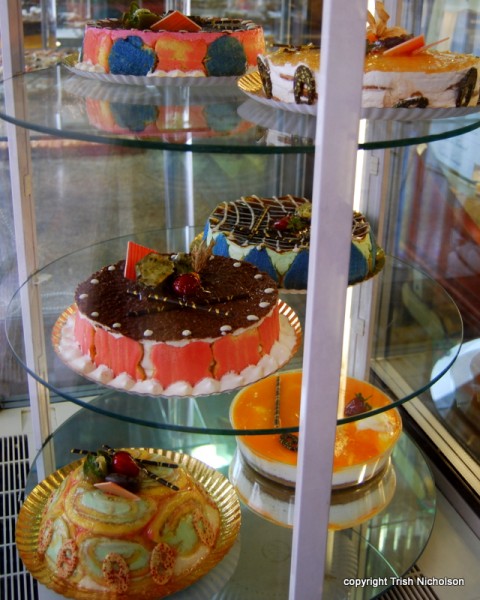 For hungry travellers eating on a budget, near the bottom of Rua das Flores, on the left, is the Marina Buffet, frequented by local workers, where I enjoyed a large vegetarian omelette with generous portions of salad and chips for 3.50 Euros (about £2.50 or NZ$5). It was near this cafe that I found a very special bookshop which I will tell you about next week, along with the famous Lello’s Lavraria and another, state of the art book and media store.
For hungry travellers eating on a budget, near the bottom of Rua das Flores, on the left, is the Marina Buffet, frequented by local workers, where I enjoyed a large vegetarian omelette with generous portions of salad and chips for 3.50 Euros (about £2.50 or NZ$5). It was near this cafe that I found a very special bookshop which I will tell you about next week, along with the famous Lello’s Lavraria and another, state of the art book and media store.
If you enjoy reading about travel, you might like my ebook travelogue, Journey in Bhutan: Himalayan trek in the Kingdom of the Thunder Dragon.

It’s years since I went to Portugal – and these wonderful pictures are just the thing to tempt me back. These are just lovely – thank you, Trish.
Hello Jo, you’re the second person this evening to tell me the post revived holidasy memories and that gives me such pleasure. Thank you for your comment 🙂
I didn’t know until I read this how lovely it is there. Imagine a McDonalds in such a lovely building what waste. I love going to places where there is so much to see you don’t know what to look at first. Lovely post.
Thank you Anne, there is lots to see and do in Porto, I’ll say more in two more posts, this was really just the first day walking around – mostly in the rain, a good excuse to try out all those cafes 🙂
I wanna go!! Trish, what beautiful pictures. You’ve given me another place I just have to see. I don’t know whether to be happy or cry lol. I think I’ll start saving now.
Laugh!So glad it inspired you, and by the time you have saved up for your big European OE they will be further on with the rehabilitation (I hope) and you won’t have to cope with so much scaffolding. You’ll have to climb that bell tower as well though – if I can do it, you can 🙂
You’re on!
=)
Brilliant!